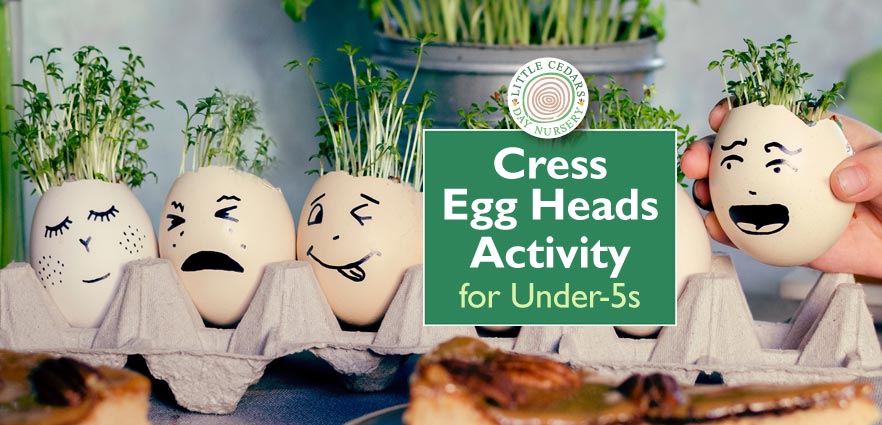
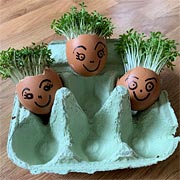 A nature-based, food-related activity that young children can enjoy indoors at any time of the year is cress growing. Today we outline how it can be made even more fun and creative for kids by growing the cress as little ‘egg heads’. These come complete with comical faces and amusing hairstyles made of green cress shoots! Children will absolutely love it when they end up with little egg faces with spouting hairstyles that each have real character. And, they’ll even be able to eat the results!
A nature-based, food-related activity that young children can enjoy indoors at any time of the year is cress growing. Today we outline how it can be made even more fun and creative for kids by growing the cress as little ‘egg heads’. These come complete with comical faces and amusing hairstyles made of green cress shoots! Children will absolutely love it when they end up with little egg faces with spouting hairstyles that each have real character. And, they’ll even be able to eat the results!
It’s an Educational Activity
This activity is suitable, under adult supervision, even for the very young. Toddlers and under-fives will learn along the way too. They’ll learn lessons about nature, how seeds grow into plants and how some plants can be turned into tasty food — all with very little effort. It will also teach children about being responsible for another living thing.
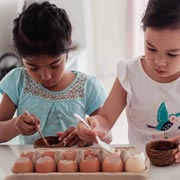 Cress is Easy to Grow, & Tasty!
Cress is Easy to Grow, & Tasty!
The good news is that cress is one of the easiest micro vegetables to grow. It can be grown more or less anywhere and with little maintenance. Historically cress was used in herbal medicine, but nowadays is used in meals for its distinctive flavour. Probably the most common use of cress is in egg and cress sandwiches. However, it’s also great in salads and makes an excellent garnish. Cress soup and cress pesto is delicious and very flavoursome!
Cress is Incredibly Nutritious!
Cress is also very nutritious. It contains potassium, Vitamin A, Vitamin C, Vitamin K and more. All these vitamins mean that cress has excellent health benefits and this beneficial micro vegetable can be easily fitted into children’s diets. Making it part of a fun activity will make it more likely that children will then eat it. There are no downsides to this excellent children’s activity!
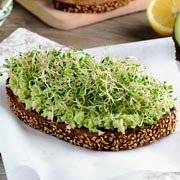 Growing Cress for Small Kids and Big Kids
Growing Cress for Small Kids and Big Kids
Cress seeds can be bought inexpensively in most garden centres and often in supermarkets. Generally, they are very cheap to buy too. You do not need to use the whole packet in one go either, so children can use only as much as they need for the activity and keep the rest in the packet for another time.
Children can grow the cress in any container they like. For this activity today, we chose to grow our cress in empty egg shell cases to create little ‘cress people’.
How to Grow Cress ‘Egg Heads’
- First, the parent should boil some eggs. Maybe do this when egg is on the menu for that day, so the cooked egg won’t be wasted.
- Then, once cooled, the tops of the eggs need to be carefully broken off. Carefully scoop out all the egg, taking care not to cause cracks anywhere, until you are left with an empty shell. Parents may need to help little children with this part.
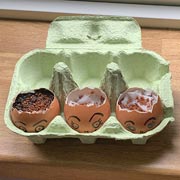 Next, find a vessel to prop the egg shells up in. This could simply be an egg cup or even an egg carton, like that shown in the photo. Then, decide what to fill the empty egg shells with. Children can choose either damp kitchen roll or damp compost/soil to grow the cress seeds on. Carefully fill the empty egg shells almost to the top with the chosen filler. (We tried both and each grew well. Interestingly, the cress seeds grown on kitchen roll tissue paper grew a little faster and therefore taller than those grown on compost. They therefore looked a bit more ‘wild’ — it was quite a surprise and had an amusing impact on the egg-people’s hairstyles).
Next, find a vessel to prop the egg shells up in. This could simply be an egg cup or even an egg carton, like that shown in the photo. Then, decide what to fill the empty egg shells with. Children can choose either damp kitchen roll or damp compost/soil to grow the cress seeds on. Carefully fill the empty egg shells almost to the top with the chosen filler. (We tried both and each grew well. Interestingly, the cress seeds grown on kitchen roll tissue paper grew a little faster and therefore taller than those grown on compost. They therefore looked a bit more ‘wild’ — it was quite a surprise and had an amusing impact on the egg-people’s hairstyles).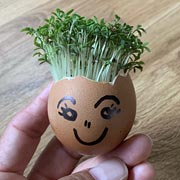 Make sure you or your child add some funny faces on the shells — maybe even give them names. The faces can be drawn simply using a marker pen (Sharpies are ideal) or you can get even more creative using coloured paints. Children may find drawing the faces easier if they are shown some visual reference and perhaps they can practise first on paper. If too young to draw suitable faces, a parent or creative older sibling may be able to help.
Make sure you or your child add some funny faces on the shells — maybe even give them names. The faces can be drawn simply using a marker pen (Sharpies are ideal) or you can get even more creative using coloured paints. Children may find drawing the faces easier if they are shown some visual reference and perhaps they can practise first on paper. If too young to draw suitable faces, a parent or creative older sibling may be able to help.- Next, your child can sprinkle some seeds onto either the damp kitchen roll or damp earth (whichever has been used to fill the egg shells).
- Place onto the windowsill and ensure that your little one gives them a small amount of water each day to stop them drying out.
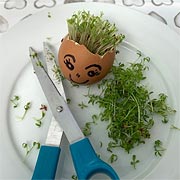 Within a week or so, the little egg heads should begin to sprout green ‘hair’ shoots!
Within a week or so, the little egg heads should begin to sprout green ‘hair’ shoots!- A few days later, you should have some funny faces with lots of sprouting hair, ready to be cut for use in sandwiches, salads, garnishes or soups. And, if you have cut the ‘hair’ rather than pulling it out by the roots, it should re-grow and give you a second head of green hair and thereby an additional crop of tasty cress to eat! We chose to make an egg and cress sandwich but you can choose your own use of the cress.
All in all, it’s a fun, educational, creative and nutritious activity that children will really love! It’s also a great opportunity for parents or adult carers to interact with little ones and to guide them and teach them insights and lessons along the way. Such interaction is priceless for under-fives.
Outstanding Childcare for Your Child at Little Cedars Nursery, Streatham
Give your baby, toddler or preschooler the very best start in life at Little Cedars Nursery, Streatham

 Little Cedars is an excellent nursery and pre-school in Streatham that provides babies, toddlers and under-5s with outstanding childcare and a first class early years education. The nursery is near Streatham Hill, Streatham Park, Streatham Common and Furzedown and also close to Tooting, Tooting Bec, Tooting Broadway, Tooting Common, Balham, Norbury and Colliers Wood. We’d love to show you and your little one around, so why not come for a free guided tour where you’ll be able to ask any questions and see how well your child fits in. Please select a button below to get in contact, arrange a tour or to apply for a place.
Little Cedars is an excellent nursery and pre-school in Streatham that provides babies, toddlers and under-5s with outstanding childcare and a first class early years education. The nursery is near Streatham Hill, Streatham Park, Streatham Common and Furzedown and also close to Tooting, Tooting Bec, Tooting Broadway, Tooting Common, Balham, Norbury and Colliers Wood. We’d love to show you and your little one around, so why not come for a free guided tour where you’ll be able to ask any questions and see how well your child fits in. Please select a button below to get in contact, arrange a tour or to apply for a place.

